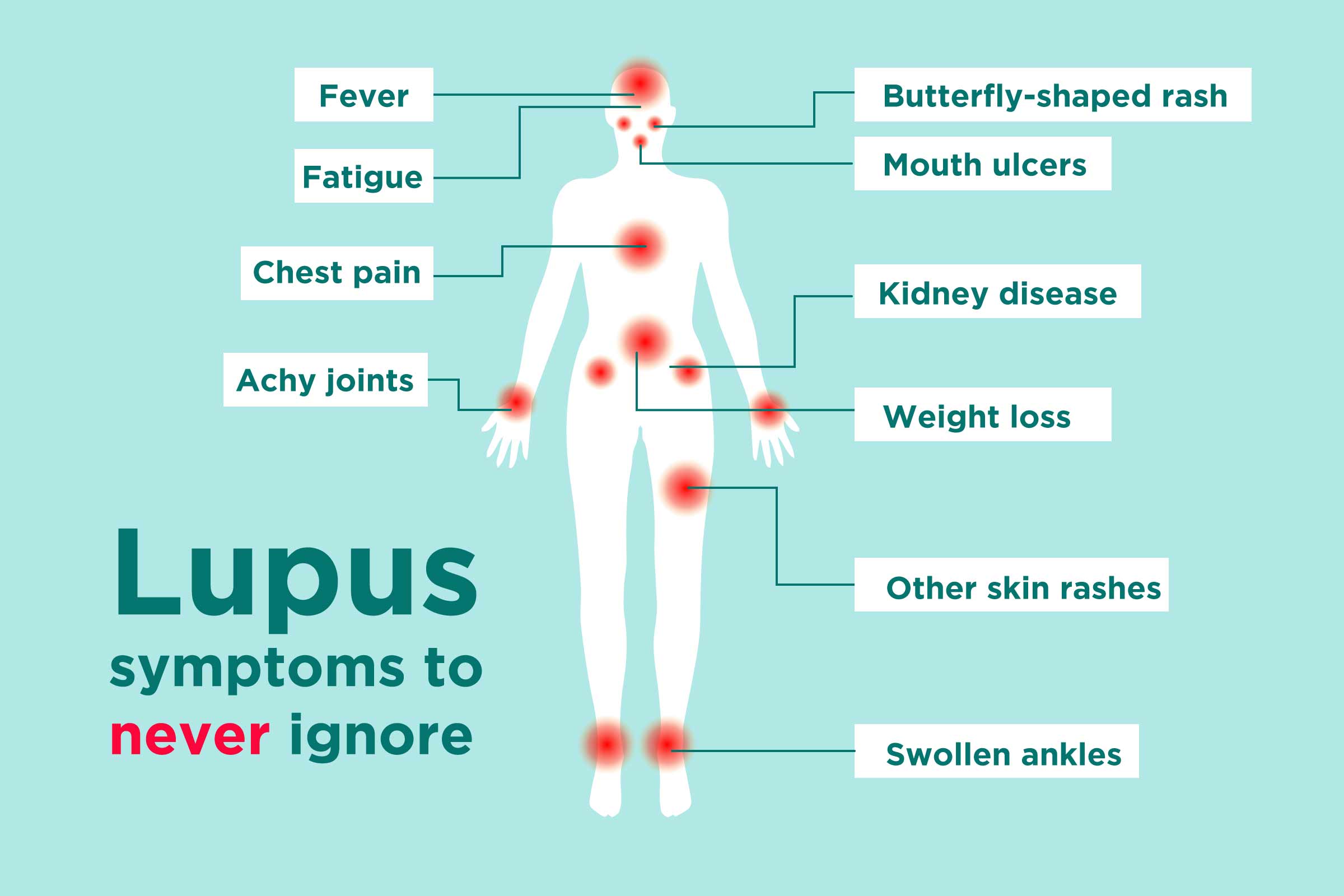
Lupus, an autoimmune disease that can affect nearly any part of the body, remains one of the most challenging conditions to diagnose. Characterized by periods of flare-ups and remissions, lupus symptoms vary greatly from person to person. Recognizing these early signs is critical for effective management and treatment. This blog will guide you through the most common and early warning signs of lupus, helping you understand how the disease develops and why you shouldn’t ignore these symptoms.
What is Lupus?
Lupus is an autoimmune disease in which the immune system mistakenly attacks the body’s own tissues, organs, and systems. This leads to inflammation and damage. While lupus can affect a variety of organs, including the skin, kidneys, heart, and joints, it commonly presents itself through various symptoms that may be overlooked or confused with other health conditions.
Lupus typically occurs in one of two main forms:
- Systemic Lupus Erythematosus (SLE): Affects multiple organs and is the most common form.
- Discoid Lupus: Primarily affects the skin, resulting in a rash.
Although lupus can develop at any age, it most commonly affects women of childbearing age, with symptoms usually appearing between the ages of 15 and 44.
Common Lupus Symptoms to Watch Out For
Lupus symptoms can appear gradually and vary in intensity. Early detection of lupus symptoms can help manage the disease more effectively. Here are some of the common signs to look out for:
1. Unexplained Fatigue
One of the most common early signs of lupus is overwhelming fatigue. This fatigue is not simply feeling tired after a long day of work; it’s a chronic sense of exhaustion that doesn’t improve with rest. Individuals with lupus often report feeling like their energy is completely drained, making it difficult to go about their daily activities. Fatigue can also accompany flare-ups, which are periods when the disease becomes more active and symptoms worsen.
2. Butterfly-Shaped Rash on the Face
A hallmark symptom of lupus is the “butterfly rash,” which appears across the nose and cheeks, forming a butterfly shape. This rash is red and may be flat or raised. It often worsens with sun exposure and is a distinctive sign of systemic lupus erythematosus (SLE). If you notice any unusual facial rash, it’s important to monitor for other symptoms that could indicate lupus.
3. Joint Pain and Swelling
Lupus often affects the joints, leading to pain, swelling, and stiffness. The joints most commonly involved are those in the hands, wrists, knees, and elbows. Joint pain caused by lupus can mimic arthritis, so it’s important to differentiate between these two conditions. Joint symptoms are usually worse in the mornings and can interfere with daily activities.
4. Photosensitivity (Sensitivity to Sunlight)
People with lupus may develop an increased sensitivity to sunlight. This condition, known as photosensitivity, causes a rash, redness, or irritation upon exposure to the sun. For many individuals with lupus, sun exposure can trigger or worsen symptoms, leading to flare-ups.
5. Chest Pain and Difficulty Breathing
Lupus can also affect the heart and lungs. One of the most serious symptoms of lupus is chest pain or tightness, which may indicate inflammation of the heart lining or the lungs (pericarditis or pleuritis). If you experience persistent chest pain or have difficulty breathing, it’s important to seek medical advice immediately, as these symptoms could indicate a lupus-related complication.
6. Hair Loss
Another common lupus symptom is hair loss, particularly in patches. This happens because lupus can cause inflammation of the scalp, leading to thinning or shedding of hair. In some cases, hair loss is temporary and recovers after treatment, but in others, it may persist. The hair loss associated with lupus is usually non-scarring, but it can still be a significant emotional and physical challenge.
7. Swollen Lymph Nodes
Lupus can lead to swollen lymph nodes, a sign that the body is fighting an infection. Lymph nodes are part of the immune system, and their swelling may indicate that the body is under stress from inflammation or infection. If you notice swollen lymph nodes without an apparent infection, it could be linked to lupus and should be checked by a healthcare professional.
8. Kidney Issues (Lupus Nephritis)
Lupus nephritis, or kidney inflammation caused by lupus, is one of the most severe complications of the disease. Early warning signs of kidney issues include dark or foamy urine, high blood pressure, swelling in the legs or ankles, and fatigue. Kidney problems can often develop without obvious symptoms, so regular medical check-ups and tests are crucial for detecting kidney damage early.
How Lupus Symptoms Affect Women
While lupus can affect both men and women, it is far more common in women, especially during their childbearing years. The hormonal differences between men and women play a significant role in the development of lupus. Estrogen, in particular, is thought to contribute to the onset and progression of the disease in women.
In addition to the symptoms listed above, women with lupus may also experience hormonal imbalances, menstrual irregularities, and complications during pregnancy, including increased risk of miscarriage, premature birth, or preeclampsia.
Warning Signs You Shouldn’t Ignore
Recognizing early warning signs of lupus can be life-saving, as prompt treatment can prevent long-term damage. Here are some additional warning signs to keep an eye out for:
- Mouth or Nose Ulcers: Painful sores in the mouth or nose that do not heal.
- Cold Fingers and Toes: A condition known as Raynaud’s phenomenon, where fingers and toes turn white or blue in response to cold or stress.
- Unexplained Weight Loss: Sudden, unexplained weight loss could be a sign of lupus flare-ups affecting the digestive system or metabolism.
- Headaches: Severe, recurring headaches, particularly those that are accompanied by nausea or vision problems, may indicate lupus involvement in the brain.
How Lupus Is Diagnosed
Diagnosing lupus can be challenging because its symptoms are similar to those of other conditions. To diagnose lupus, doctors rely on a combination of:
- Blood Tests: Antinuclear antibody (ANA) tests are commonly used to detect the presence of antibodies that may indicate lupus.
- Urinalysis: To check for signs of kidney involvement.
- Imaging: X-rays or ultrasounds may be used to check for joint or organ damage.
- Physical Exam: A thorough examination to look for telltale signs like the butterfly rash or joint swelling.
A rheumatologist, a doctor specializing in autoimmune diseases, is typically the physician who diagnoses and treats lupus.
The Importance of Early Detection and Treatment
The earlier lupus is diagnosed, the more likely it is that the disease can be managed effectively. There is no cure for lupus, but with the right treatment, individuals with lupus can lead healthy, fulfilling lives. Treatments for lupus may include:
- Medications: Nonsteroidal anti-inflammatory drugs (NSAIDs), corticosteroids, immunosuppressants, and antimalarial drugs are often used to manage inflammation and control the immune response.
- Lifestyle Modifications: A healthy diet, regular exercise, and stress management techniques can help reduce the frequency and severity of flare-ups.
- Regular Monitoring: Regular check-ups with your doctor can ensure that symptoms are being managed and any potential complications are caught early.
Conclusion: Don’t Ignore the Signs of Lupus
Lupus symptoms can range from mild to severe, but one thing is clear: early detection is key to preventing serious complications. If you or someone you know is experiencing any of the early warning signs of lupus, it’s essential to seek medical advice right away. By understanding the symptoms of lupus and knowing when to seek help, you can manage the disease effectively and lead a better quality of life. Always consult with a healthcare provider to get the appropriate diagnosis and treatment plan tailored to your needs.
Remember, while lupus may be a lifelong condition, with the right support and treatment, it is possible to live a full and active life.
